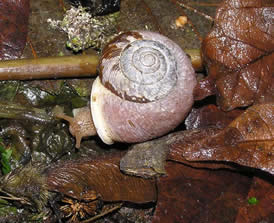

NATURE NOTES

Oregon Forestsnail (Allogona townsendiana), photo by Hugh Griffith
At a snail's pace
by
I was in south Langley with four other biologists, on a forested hillside among gravel pits that not long ago were forested hillsides. The area is one of the last known refuges of one of the more modest and most endangered members of the local forest community – the Oregon Forestsnail.
One of the odder things about the forestsnail is that it isn’t a typo (i.e., not a forest snail). One of the sadder things is that it is on the verge of being eliminated from BC, because its range includes lowlands that have been absorbed into Fraser Valley farmland, and, in south Langley, forest communities atop gravel deposits.
The Oregon forestsnail is one of the largest snails in southwest BC, about the diameter of a loonie. They are difficult to find in fall, with their brown whorls blending into the fallen leaves. You are more apt to come across one on a trail in spring when they are expressing snail wanderlust. Their biology is poorly known, but they are believed to favour areas dominated by bigleaf maple trees. We found, to our chagrin, that they are particularly fond of habitats that contain large patches of stinging nettles, which are plants covered in acid-filled hairs. We were able to keep track of each other in the forest by the "Ows."
The reason we believed forestsnails would be there among the nettles was that one of us is a very experienced researcher who has kept decades of detailed field notes. Glenn is somewhat of a legend, mostly self-taught, and has a connection to the natural world that even other naturalists have difficulty comprehending. He had seen them there before, but not at this time of year.
At the bottom of a slope, Glenn decided we should push our way through the elderberry branches to another bigleaf maple that dominated that spot. Sure enough, after we scratched around in the leaf litter for a while, a forestsnail was found.
The Oregon forestsnail is a long-lived, slow-moving animal that is food for many other animals, a small but significant part of the ecosystem. It is a silent, elegant thing, almost invisible to human eyes. Unfortunately, its limited profile cannot compete with the economic appeal of a gravel pit or a housing development, and so as the landscape changes, the forestsnail disappears.
When I returned home, muddied from crawling around in leaf litter, fingers still stinging from nettles, my wife asked, "So did you find one?"
I proudly clicked my camera to the shot
She laughed, "You’re pretty excited over a snail."
But it wasn’t a snail. It was a Forestsnail.
Hugh Griffith is a BC zoologist and science writer.
Please cite these pages as:
Author, date, page title. In: Klinkenberg, Brian. (Editor) 2023. E-Fauna BC: Electronic Atlas of the Fauna of British Columbia [www.efauna.bc.ca]. Department of Geography, University of British Columbia, Vancouver. [Date Accessed]
© Copyright 2023 E-Fauna BC.